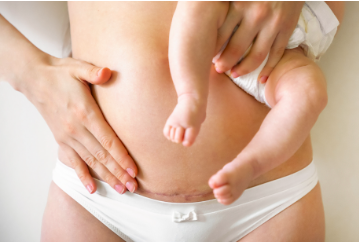
Written by Karina Jackson, MSc OT, PMH-C
The transition to parenthood is typically a dynamic and challenging period for birthing parents and their partners, as they adapt to significant lifestyle changes and assume new responsibilities. The perinatal period (which encompasses pregnancy and up to one year after giving birth) is a critical time in which the birthing person’s body undergoes hormonal shifts, weight changes, mood fluctuations, and changes in blood circulation.
The hormone relaxin, which is produced in higher quantities during pregnancy, helps relax the ligaments in the body and aims to prepare the pelvis for childbirth. The increased levels of relaxin affect not only the pelvic area but also other joints, muscles, and ligaments throughout the body. As a result, increased joint flexibility and mobility are typically experienced in pregnancy and can persist during the postpartum period. That said, the body is more susceptible to injury during the perinatal period and so it is important to be cautious about repetitive and awkward movements, especially when engaging in activities such as lifting, carrying, and nursing a newborn.
As an occupational therapist specialized in hand therapy and maternal health, I have met many postpartum clients with difficulties related to functionally limiting pain at the thumb side of the wrist. A quick google search of their symptoms may have yielded the more commonly known term “mommy’s thumb” or the clinical term “De Quervain’s tenosynovitis”. If you are up for a geeky deep dive, De Quervain’s tenosynovitis involves the abductor pollicis longus (APL) and extensor pollicis brevis (EPB) tendons and occurs when the tendons are inflamed and unable to glide smoothly, thus causing pain, inflammation, and swelling. Tendons are strong, fibrous connective tissues that connect muscles to bones, which means that they play a crucial role in enabling the movement of our skeleton and providing stability. While some of these terms may be a mouthful, the key point here is that the affected tendons are responsible for straightening and moving the thumb away from the palm, which is a frequently used movement in everyday tasks and parenting occupations.
What is the cause?
While the exact underlying cause remains unclear, symptoms of thumb tendonitis can be triggered by repetitive thumb and wrist movements involved in various activities. These activities may include lifting a baby or child, opening containers and jars, or repeatedly using the thumb for texting on a phone. Thumb tendonitis is often observed among pregnant women or caregivers of young children who frequently lift or hold them.
What are the symptoms?
- Swelling at the base of the thumb
- Painful popping when pulling, lifting, or opening containers
- Raised nodule within the thumb area
- Pain with gripping or pinching
How is De Quervain’s diagnosed?
- A primary care provider, specialized physician or hand therapist may use provocative
tests, which are specific physical examination maneuvers used to assess the presence of
certain hand/wrist conditions by reproducing or exacerbating symptoms. - X-ray imaging is not typically needed but can be used to rule out other conditions.
- An ultrasound procedure can be used to produce images for diagnostic purposes.
How can we treat it?
Treatment should aim to reduce pain and inflammation and improve the person’s functional use of the hand and thumb. Such treatments include, but are not limited to, the following:
- Activity modification refers to adjusting one’s daily activities to accommodate an injury.
-
- To minimize strain on the hands while lifting and carrying your baby, avoid using
a wrist position where it is bent towards the thumb side, with the thumb extended
away from the palm. An alternative method is to lift your baby by placing one
hand under their bottom and the other hand supporting their back/neck. Also,
when lifting and cradling your baby, keep the thumbs close to the palm. Using the
entire hand for support helps avoid unnecessary stress on the thumbs. - When breastfeeding or bottle feeding, it is important to be mindful of hand positioning to support your baby comfortably. Keep your thumbs close to the palm (i.e., glued to the index finger) as your cradle your baby’s head. Avoid excessively bending the wrist forwards or backwards for extended periods of time.
- Avoid repetitive gripping or pinching activities with the injured thumb, such as opening diaper tabs or tight bottles.
- To minimize strain on the hands while lifting and carrying your baby, avoid using
-
- Splints or custom orthoses can be worn to keep the thumb and wrist in a neutral position and to provide support as you perform activities that may aggravate your symptoms.
- Stretching and resting the thumb and wrist can promote healing of the tendons. Consider
delegating strenuous tasks to your close family and friends to allow periods of rest. - Corticosteroid injection and anti-inflammatory medications may be prescribed by a
medical doctor to help reduce inflammation.
During pregnancy or after becoming a new parent, De Quervain’s tenosynovitis is one of the most frequently observed upper extremity conditions (Wagner, 2019). However, it is possible to prevent injury while attending to the needs of your newborn by modifying your activities and using ergonomic principles to position your body in a favourable way. If you are experiencing persistent symptoms of De Quervain’s, please consult your primary care provider and an occupational therapist.
References
American Society for Surgery of the Hand. (2018). What is mommy’s wrist? Retrieved from http://blog.handcare.org/blog/2018/12/19/what-is-mommys-wrist/
Avci, S., Yilmaz, C., & Sayli, U. (2002). Comparison of nonsurgical treatment measures for de Quervain’s disease of pregnancy and lactation. The Journal of hand surgery, 27(2), 322–324. https://doi.org/10.1053/jhsu.2002.32084
Wagner, A. (2019). Upper Extremity Pain in Breastfeeding Mothers: A Narrative Review of the Literature. Journal of Hand Therapy, 32, 560-561.





